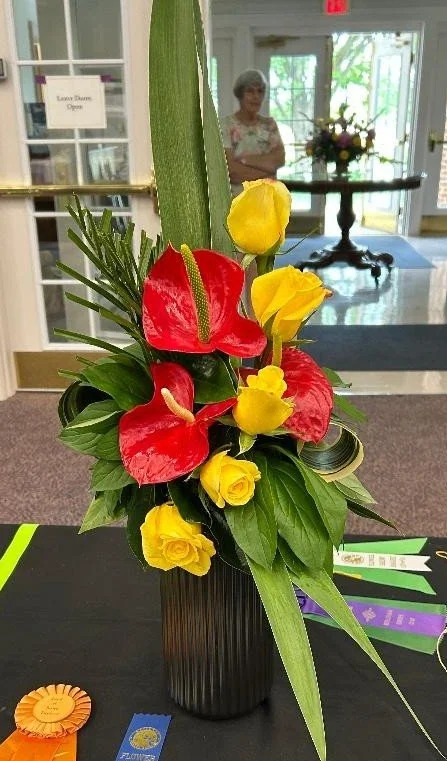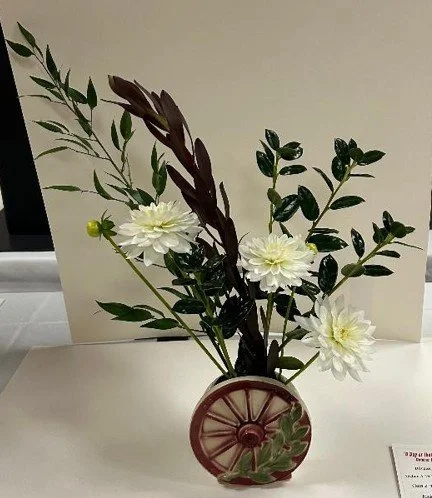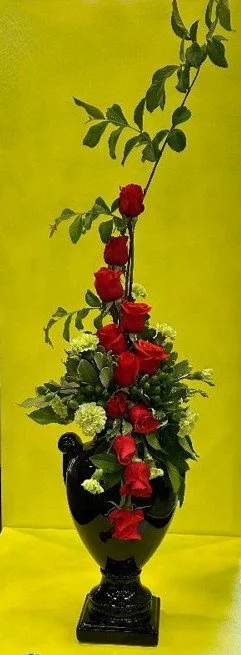Floral Design
Ready to learn the basics OR up your design game?
A Look Inside Floral Design
by Val Story
Have you ever wanted to learn more about flower arranging? I know I did before I started my journey becoming a flower show judge. I always like the simplest way to do a design also with not too many flowers. The vase or container is vital to the flower arrangement, but should not overpower the design. There are a few basic things to know about flower arrangements, and this is what can apply to all art work. This is also how flower show judge’s judge.
The pictures show here are not difficult flower arrangements, but show what and how one may create different looks, use different vases (containers) and use height in the design. Fresh or dried plant material may be used.
Attributes of a design: Beauty, Distinction, Expression and Harmony
Elements of Design:
The visual qualities of a design
1. Color: the result of light striking an object and bring reflective to the eye
2. Form: 3 D aspects of design. Form and space closely related. Open forms and closed forms
3. Light: Is necessary for vision. Light can modify form, affect color and textures and effects depth. Natural and artificial
4. Line: One dimensional visual path through a design giving rhythm and direction
5. Pattern: natural or handmade created by lines, forms and spaces and colors
6. Size: the perceived or visual dimension of components. Affected by distance of the viewer, color, form and texture
7. Space: The open areas in an around the design. Total space or frame of reference. Space within plant material and in the design
8. Texture: Surface quality. Adds interest, decreases monotony. One of first thing a person see is texture and color
Principles of Design
The basic standards used to judge all visual art
1. Balance: top to bottom, side to side or symmetrical or asymmetrical first thing you see.
2. Contrast: Of the elements: Color: dark/light Form: round/elongated Light: strong/subtle Line: thick/thin curved/straight/ angular Pattern: bold/subtle Size: large/small Space: open/closed Texture: rough/smooth
3. Dominance: the emphasis of one component over another. Very influential part of the design, helps produce unity
4. Proportion: the relationship between the amounts and quantities: Frame of Reference: relationship between the design and total space.
5. Rhythm: Dominant visual movement throughout the design by repetition of the elements or gradation.
6. Scale: Size relationship of one object in a design to the other. Size is one on one where proportion is the whole space. Components are out of scale when the variation of size is too great.
Horticulture
What does that mean?
Horticulture can be defined as the science and art of growing fruits, vegetables, herbs, nuts, seeds, mushrooms, algae, flowers, seaweeds, and non-food crops such as grasses and ornamental trees and plants. Horticulture is a specialized branch of agriculture that deals with specific techniques that enhance plant growth, quality, yield, and sustainability. Oh golly, that sounds too boring and technical, but oh so necessary to our lives.
How about plants and flowers: something we all love and many of us grow in our yards for the beauty, cutting flowers for our home or growing vegetables.
For garden clubs: we love to use plants/cut specimens (a cut flower with a stem and leaves, a branch, an herb, a grass or potted plant: these are all specimens) to show what we have in our yard. This is either shown in a glass bottle and in a design (floral arrangement). All members in a garden club may participate in bringing a plant (horticulture) to the meetings. This is encouraged!
Bringing Horticulture to a garden club meeting is an opportunity for local amateur growers (club members) to showcase their work and connect with other members to share knowledge and expertise in gardening skills.
As one of the two most important Divisions of a Flower Show, the Horticulture Division gives us the opportunity to see plants at their best. Excellence in exhibiting standards, clean unblemished specimens, and variety of genus, species, and cultivars, give the gardener inspiration to find new ideas for growing plants they may not have considered before. And to be able to see and learn. There are so many unusual plants.
A class is a group of individual specimens conforming to the same specifications (cut flower/bulb or sunflowers or potted plants) and that have some similarity. Tulips may be in a class or roses in a different class. All of these must be grown by the person bringing the plant to be displayed at the garden club meeting. So, no highway picking!!
Horticulture is a must to sustain life for humans and animals, but oh such a beauty - we all may participate.
Contributed by: Val Story









